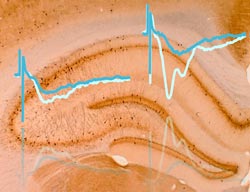How the brain stays receptive: researchers examine the role of channel protein in learning

Micrograph of the hippocampus: The blue curves show the long-term potentiation in mice with (left) and without Pannexin1 (right). Brains of animals without the channel protein respond especially sensitively to small stimuli, as the big difference between the light and dark blue curve shows. The data is based on original measurements of the study.<br>Image: Nora Prochnow<br>
The channel protein Pannexin1 keeps nerve cells flexible and thus the brain receptive for new knowledge. Together with colleagues from Canada and the U.S., researchers at the Ruhr-Universität Bochum led by the junior professor Dr. Nora Prochnow from the Department of Molecular Brain Research describe these results in PLoS ONE.
In the study, mice comprising no Pannexin1 in memory-related brain structures displayed symptoms similar to autism. Their nerve cells lacked synaptic plasticity, i.e. the ability to form new synaptic contacts or give up old contacts based on the level of usage.
Pannexins are abundant in the central nervous system of vertebrates
Pannexins traverse the cell membrane of vertebrate animals and form large pored channels. They are permeable for certain signalling molecules, such as the energy storage molecule ATP (adenosine triphosphate). The best known representative is Pannexin1, which occurs in abundance in the brain and spinal cord and among others in the hippocampus – a brain structure that is critical for long-term memory. Malfunctions of the pannexins play a role in the development of epilepsy and strokes.
No more scope in long-term potentiation
The research team studied mice in which the gene for Pannexin1 was lacking. Using cell recordings carried out on isolated brain sections, they analysed the long-term potentiation in the hippocampus. Long-term potentiation usually occurs when new memory content is built – the contacts between nerve cells are strengthened; they communicate more effectively with each other. In mice without Pannexin1, the long-term potentiation occurred earlier and was more prolonged than in mice with Pannexin1. “It looks at first glance like a gain in long-term memory”, says Nora Prochnow. “But precise analysis shows that there was no more scope for upward development.” Due to the lack of Pannexin1, the cell communication in general was increased to such an extent that a further increase through the learning of new knowledge was no longer possible. The synaptic plasticity was thus extremely restricted. “The plasticity is essential for learning processes in the brain”, Nora Prochnow explains. “It helps you to organise, keep or even to forget contents in a positive sense, to gain room for new inputs.”
Autistic-like behaviour without Pannexin1
The absence of Pannexin1 also had an impact on behaviour: when solving simple problems, the animals were quickly overwhelmed in terms of content. Their spatial orientation was limited, their attention impaired and an increased probability for seizure generation occurred. “The behavioural patterns are reminiscent of autism. We should therefore consider the Pannexin1 channel more closely with regard to the treatment of such diseases”, says the neurobiologist from Bochum.
Theory: feedback regulation gets out of hand without Pannexin1
According to the scientists’ theory, nerve cells lack a feedback mechanism without Pannexin1. Normally the channel protein releases ATP, which binds to specific receptors and thus reduces the release of the neurotransmitter glutamate. Without Pannexin1 more glutamate is released, which leads to increased long-term potentiation. This causes the cell to lose its dynamic equilibrium, which is needed for an efficient learning process.
Bibliographic record
N. Prochnow, A. Abdulazim, S. Kurtenbach, V. Wildförster, G. Dvoriantchikova , J. Hanske, E. Petrasch-Parwez, V.I. Shestopalov, R. Dermietzel, D. Manahan-Vaughan, G. Zoidl (2012): Pannexin1 stabilizes synaptic plasticity and is needed for learning, PLoS ONE , DOI: 10.1371/journal.pone.0051767
Further information
Prof. Dr. Nora Prochnow, Department of Molecular Brain Research, Faculty of Medicine, 44780 Bochum, Germany, Tel. +49/234/32-24406, E-Mail: Nora.Prochnow@ruhr-uni-bochum.de
Editor: Dr. Julia Weiler
Media Contact
More Information:
http://www.ruhr-uni-bochum.deAll latest news from the category: Life Sciences and Chemistry
Articles and reports from the Life Sciences and chemistry area deal with applied and basic research into modern biology, chemistry and human medicine.
Valuable information can be found on a range of life sciences fields including bacteriology, biochemistry, bionics, bioinformatics, biophysics, biotechnology, genetics, geobotany, human biology, marine biology, microbiology, molecular biology, cellular biology, zoology, bioinorganic chemistry, microchemistry and environmental chemistry.
Newest articles

Recovering phosphorus from sewage sludge ash
Chemical and heat treatment of sewage sludge can recover phosphorus in a process that could help address the problem of diminishing supplies of phosphorus ores. Valuable supplies of phosphorus could…

Efficient, sustainable and cost-effective hybrid energy storage system for modern power grids
EU project HyFlow: Over three years of research, the consortium of the EU project HyFlow has successfully developed a highly efficient, sustainable, and cost-effective hybrid energy storage system (HESS) that…

After 25 years, researchers uncover genetic cause of rare neurological disease
Some families call it a trial of faith. Others just call it a curse. The progressive neurological disease known as spinocerebellar ataxia 4 (SCA4) is a rare condition, but its…





















